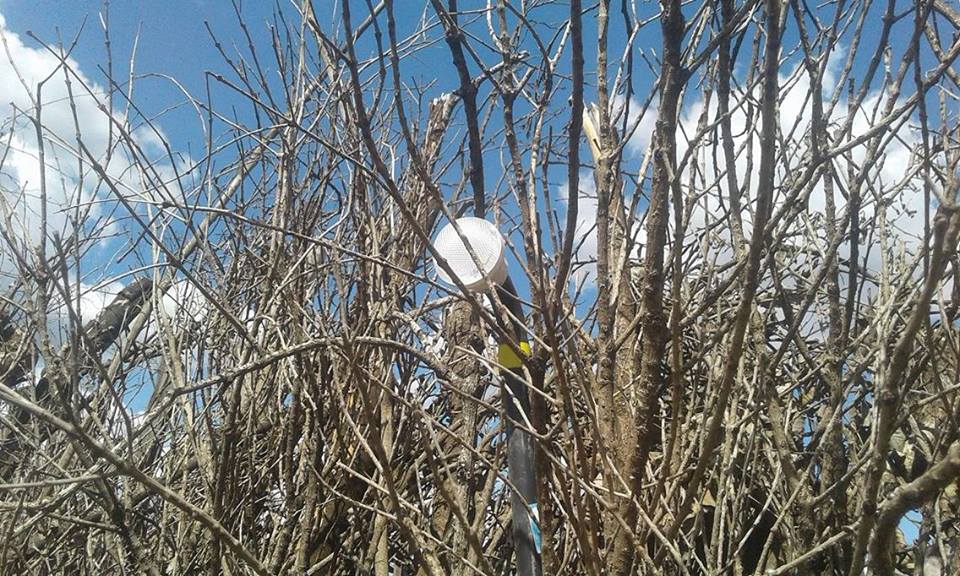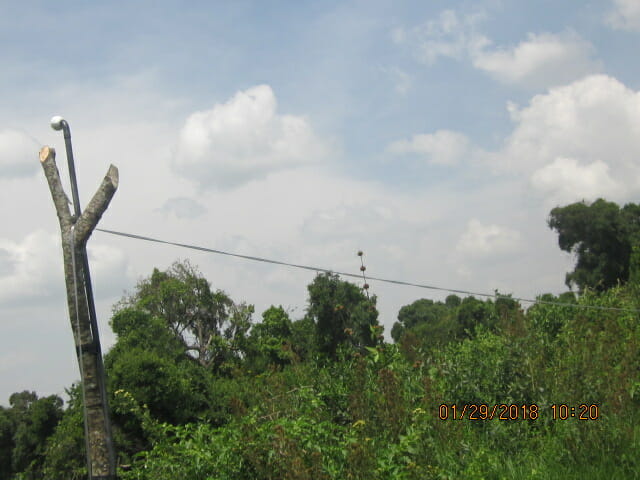Mara Elephant Project has a human-elephant toolkit that we consider to be our best practices in mitigating human-elephant conflict. All of the methods found in this toolkit are practices we’ve seen to be effective from partners and implemented, for example the use of a helicopter, or are practices we’ve tested and made into our own, like chili fences and unmanned aerial vehicles.
One such method that is new for MEP and has exciting potential are flashing light fences. MEP got the idea from predator conservation organizations that were using them with great success around bomas to keep cattle safe from lions. The device is essentially a system of light bulbs that flash intermittently that simulate the movement of a person around a boma and thereby deter predators. 
A Light for Life photo of a Lion Entry Deterrent Light being installed around a boma.
Since these fences were proven so effective at keeping predators away from farm animals, MEP thought they’d be equally as effective in keeping elephants out of crops. The fences involve using solar panels and lights all connected with cables and stuck on top of posts that are secured around the crops. The flashing lights are all solar powered, so they are able to recharge during the day to be used primarily at night when the majority of crop raiding occurs.
The Transmara at the beginning of 2018 was a high conflict area with crops ripening and hungry elephants going into farms almost nightly. Our Transmara team was desperate for a new mitigation method that would be permanent and cost effective. MEP rangers built the first flashing light fence in the Transmara in January and so far, it’s been working wonderfully. Every time MEP rangers were called into a farm to chase elephants out using flash bangs, the elephants had already moved on from other farms because of the bright lights.
 MEP rangers installing a flashing light fence in the Transmara.
MEP rangers installing a flashing light fence in the Transmara.
The flashing lights around a farm caused enough of a disruption that elephants stayed out of the farms. One MEP ranger noted that a farmer was so grateful to MEP for being able to spend a whole night sleeping.

The flashing light fence in the Transmara.
The new flashing light fence is a cheap and effective mitigation tool even compared to chili fences. The fences are installed by MEP rangers who were trained by Kenyan conservationist David Mascall, who has been installing Lion Entry Deterrent Lights for years with great success. Community members also help with installation and their only task after installation is to ensure the lights don’t get stolen, which they’ve reported is a much easier task than keeping elephants out of their farms.

David Mascall of Light For Life demonstrates how he installs Lion Entry Deterrent (LED) lights to some members of Friends of Nairobi National Park by Shots by Sema.
The whole solar light kit includes eight bulbs that cover 100 meters costing just $300. MEP has started with five total units that allowed us to install 500 meters of fencing in the Transmara for just $1,500. We’ve already found this method to be much more sustainable than chili fences, which are not reusable because the chili powder and used engine oil mixture runs off after every rain. Additionally, with chili fences, they keep elephants out, but other wildlife is undeterred.
MEP can see that the flashing light fences are going to become a permanent part of the MEP human-elephant conflict toolkit and are already a great asset that can be reused during high conflict seasons like harvest and uninstalled during low conflict seasons.


